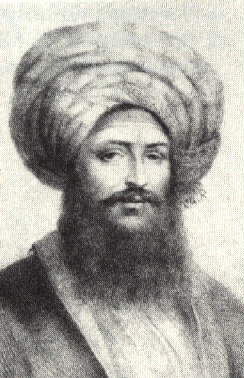While living in England, Belzoni invented a hydraulic machine. Belzoni left the circus but still under contract, he and his wife Sarah traveled to Spain and Portugal and then on to Cairo, Egypt. In Cario Belzoni met an agent of Mohammed Ali, Pasha of Egypt. He offered his invention of a hydraulic machine to Mohammed Ali Pasha to move water. Though the machine worked well enough, the Pasha was not interested.
Belzoni met up with his former patron British Consul General Henry Salt in Egypt. Salt convinced Belzoni that there was money to be made by gathering artifacts to send to the British Museum. Belzoni traveled to Thebes "to remove the colossal stone head of Ramses II to be delivered to the British museum". The head weighed over 7 tons and had up to that point proved impossible to move. Following were journeys to the temple Edfu, Philae, and Elephantine. Here he also "cleared the great temple of Ramses II at Abu Simbel, excavated at Karnak."
He later was able to acquire for the British Museum the two seated statues of Ramses II from Luxor. The statues had been almost entirely buried in sand. It was due to his knowledge of hydraulics that enabled Belzoni to remove so many large statues that ended up in the British Museum. By 1817 Belzoni was in the Valley of Kings making incredible discoveries. Not only did he discover the tombs of Ramses I, Merneptah, Ay and Amenhotep III, he found the entrance to Seti I's sepulchre. Seti I was the son of Ramses I.
At Giza, Belzoni became the first modern man to go deep within the pyramid of Kafre, in 1818. Belzoni wrote about his finds in his book, Narrative of the Operations and Recent Discoveries Within the Pyramids, Temples, Tombs, and Excavations in Egypt and Nubia, which was the first research published about Egyptology in England. An exhibition in May of 1821, called Egyptian Hall, in Piccadilly, displayed Belzoni's expeditions and contained plaster casts from the tomb of Seti I.
Belzoni caught dysentery in northwestern Africa while on an excavation and died on December 3, 1823 at Gato in Benin (was Dahomey) and is buried in Gwata, a nearby village. Despite his fame, his widow lived the rest of her days in poverty.
Belzoni was typical of early explorers in Egypt who looted tombs. Their "excavations" were often very destructive and few were seeking archaeological knowledge - they were seeking hidden treasure to sell to collectors and museums. But despite his destructive methods of acquiring artifacts, Belzoni was still credited with laying the foundation for the scientific study of Egyptology. Howard Carter called Belzoni "one of the most remarkable men in the entire history of Archaeology."
BIO original by the Musuum of Minnesota State University.
While living in England, Belzoni invented a hydraulic machine. Belzoni left the circus but still under contract, he and his wife Sarah traveled to Spain and Portugal and then on to Cairo, Egypt. In Cario Belzoni met an agent of Mohammed Ali, Pasha of Egypt. He offered his invention of a hydraulic machine to Mohammed Ali Pasha to move water. Though the machine worked well enough, the Pasha was not interested.
Belzoni met up with his former patron British Consul General Henry Salt in Egypt. Salt convinced Belzoni that there was money to be made by gathering artifacts to send to the British Museum. Belzoni traveled to Thebes "to remove the colossal stone head of Ramses II to be delivered to the British museum". The head weighed over 7 tons and had up to that point proved impossible to move. Following were journeys to the temple Edfu, Philae, and Elephantine. Here he also "cleared the great temple of Ramses II at Abu Simbel, excavated at Karnak."
He later was able to acquire for the British Museum the two seated statues of Ramses II from Luxor. The statues had been almost entirely buried in sand. It was due to his knowledge of hydraulics that enabled Belzoni to remove so many large statues that ended up in the British Museum. By 1817 Belzoni was in the Valley of Kings making incredible discoveries. Not only did he discover the tombs of Ramses I, Merneptah, Ay and Amenhotep III, he found the entrance to Seti I's sepulchre. Seti I was the son of Ramses I.
At Giza, Belzoni became the first modern man to go deep within the pyramid of Kafre, in 1818. Belzoni wrote about his finds in his book, Narrative of the Operations and Recent Discoveries Within the Pyramids, Temples, Tombs, and Excavations in Egypt and Nubia, which was the first research published about Egyptology in England. An exhibition in May of 1821, called Egyptian Hall, in Piccadilly, displayed Belzoni's expeditions and contained plaster casts from the tomb of Seti I.
Belzoni caught dysentery in northwestern Africa while on an excavation and died on December 3, 1823 at Gato in Benin (was Dahomey) and is buried in Gwata, a nearby village. Despite his fame, his widow lived the rest of her days in poverty.
Belzoni was typical of early explorers in Egypt who looted tombs. Their "excavations" were often very destructive and few were seeking archaeological knowledge - they were seeking hidden treasure to sell to collectors and museums. But despite his destructive methods of acquiring artifacts, Belzoni was still credited with laying the foundation for the scientific study of Egyptology. Howard Carter called Belzoni "one of the most remarkable men in the entire history of Archaeology."
BIO original by the Musuum of Minnesota State University.







